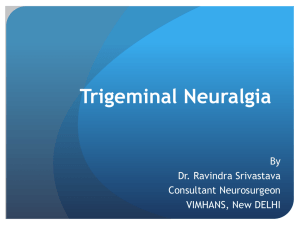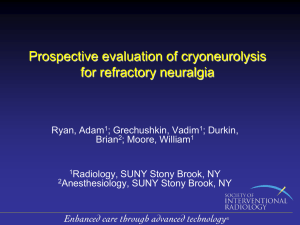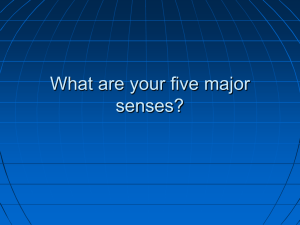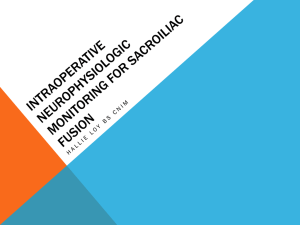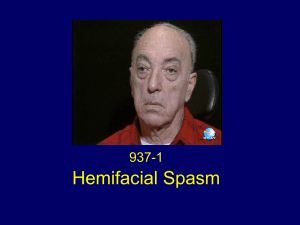CHRONIC PAIN SYNDROME
advertisement
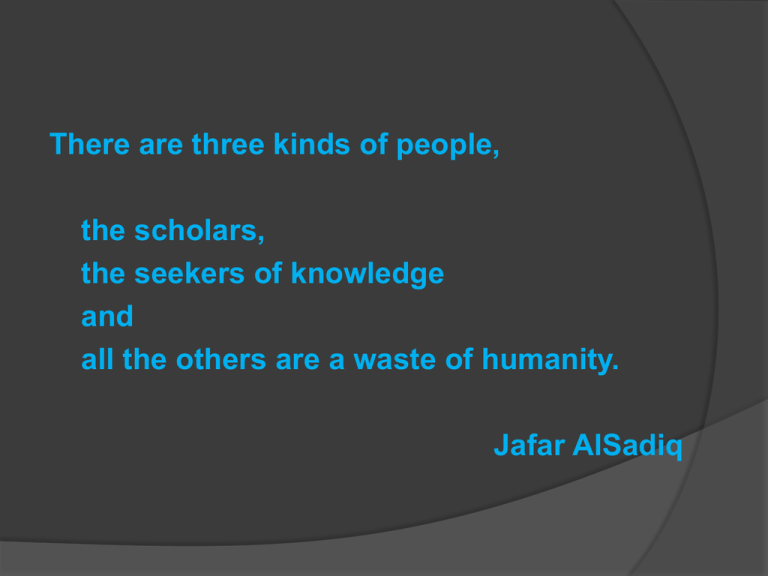
There are three kinds of people, the scholars, the seekers of knowledge and all the others are a waste of humanity. Jafar AlSadiq Dr. Nasir Imran Zaidi Consultant Anaesthetist, Railway General Hospital Assistant Professor, Islamic International Medical College Rawalpindi doctornasir@yahoo.com This presentation and its relevant material can be obtained by sending an email to doctornasir@yahoo.com Available to all those who take part in propagation of the knowledge Chronic Pain Chronic Pain define as: Pain persists beyond either the course of an acute disease or reasonable time for an injury to heal Pain is associated with chronic pathological process Pain that recurs at interval of months or year Chronic Pain Syndrome I Malignant Cancer pain syndrome II Non-Malignant Nociceptive Neuropathic Psychogenic Nociceptive Low back pain Myofacial pain Visceral pain Headache and facial pain Neck and shoulder pain Neuropathic pain Sympathetically mediated pain Post herpetic neuralgia Trigeminal neuralgia Phantom pain Modalities of Pain Management I Pharmacological II Anaesthesiologic III Special technique * Facet Blocks * Acupuncture (Gate control theory) * Cryolysis * Ablative technique * Radio frequency * Physical therapy Contd... Pharmacological Analgesic Paracetamol NSAID Opioids Co-analgesics Anti-depressant Anti-convulsant Contd... Anesthisiologic Central nerve blocks ○ Spinal ○ Epidural Peripheral nerve blocks ○ Femoral ○ ICN ○ Others Autonomic Nerve blocks ○ Stellete ganglion ○ Lumber Sympathectomy Special Technique Contd... Facet block for back pain Cryolysis for nerve damage Radio frequency for facet joint / nerve damage Acupuncture 361 classical acupuncture points lie along specific pathway or meridians Ablative neuro-surgical procedure - interrupt sensory pathways to the brain or in the brain and brain stem. Low Back Pain Most common condition seen in the pain clinic Major causes: Prolapse inter-vertebral disc Facet joint degeneration Sacroiliac joint arthritis Musculoskeletal disorder Miscellaneous Prolapsed Intervertebral Disk Management of Low Back Pain Do not miss a treatable cause of pain in the rush to treat the symptoms Pain alone decompression may not justify surgery like laminectomy or micro-discectomy Treatment Options Drug therapy vs nerve block procedure drug therapy NSAID, week opioids & other support therapy Low morbidity out patient ○ Epidural steroid ○ Facet joint steroid injection ○ Sacroiliac steroid injection As a first line of treatment Myofacial Pain Syndrome Pathogenesis The likely has a central mechanism, with peripheral clinical manifestations. Causes Abnormal stresses on the muscles from sudden stress on shortened muscles, leg-length discrepancies, or skeletal asymmetry Poor posture, static position for a prolonged period of time Chronic infections and sleep deprivation Anemia and low levels of calcium, potassium, iron, and vitamins C, B-1, B-6, and B-12 are believed to play a role radiculopathy, visceral diseases, depression, Hypothyroidism, hyperuricemia, and hypoglycemia Complex Regional Pain Syndrome : CRPS Recently the sub-committee on taxonomy of IASP has replaced the terms RSD and Causalgia to regional pain syndrome (CRPS) RSD - CRPS I Causalgia - CRPS II Chronic Sympathetically Mediated Pain (SMP) Reflex sympathetic dystrophy (RSD) and causalgia RSD A group of condition associated with extremity pain and autonomic dysfunction Causalgia Specific syndrome of burning pain and autonomic dysfunction associated with major nerve trunk injury. SMP / SIP SMP (sympathetically mediated pain) SIP (sympathetically independent pain) Majority of CRPS are associated with SMP but fewer cases are found to be SIP. Treatment Options of CRPS Drug therapy Antidepressant Anti convulsant Narcotic analgesic Oral nifedipine Adrenergic blocking agents Nerve Block Chemical sympathectomy Intravenous regional block (Bier’s Block) Physical therapy Tens therapy Post-herpetic neuralgia Pain in the distribution of a nerve It follows an acute herpetic attack (shingles) Incidence: 3-4 per 1000 Clinically: Burning pain constant deepache crawling or scratching pain stabbing or shooting Management Drug therapy (main stay) Anticovulsant Anti depressant Nerve block Little role Trigeminal Neuralgia Conditions occur more often in Female middle aged Strictly unilateral, however in 2% it may be bilateral Pain in the face is characterized by sharp, severe (paroxysmal) and brief lasting no more then a few seconds. Management of Trigeminal Neuralgia Drug Therapy Anti-convulsant Anti depressant Nerve block Cryo-analgesia Radio-frequency Malignant Pain Syndrome Incidence 70% of cancer patients suffer from pain as a symptoms Management Strategies Pharmacological methods Interventional pain management neurolytic blocks Intraspinal drug delivery system Others physical therapy Tens therapy Pharmacologic therapy “Analgesic staircase” Strong opioids +/- adjuvant Weak opioids +/- adjuvant Non-opioids NSAID +/adjuvant Invasive Procedures When pain or side effects persist despite comprehensive trials of pharmacologic therapy I Neurolytic blocks ○ Coeliac plexus ○ Hypogastric plexus II Intra-spinal drug delivery ○ short terms – intrathecal or epidural infusion ○ long term – implants CONCLUSION Control of pain in chronic pain syndrome can be achieved in most patients by the application of a carefully individualized, flexible programme of : analgesic drugs Interventional pain management Certainly, knowledge is a lock and its key is the question Ja'far al-Sadiq Quote by: as The teacher of Jabir ibn Hayyan, an astronomer, alchemist, Islamic scholar, Islamic theologian, writer, philosopher, physician, physicist and scientist.

